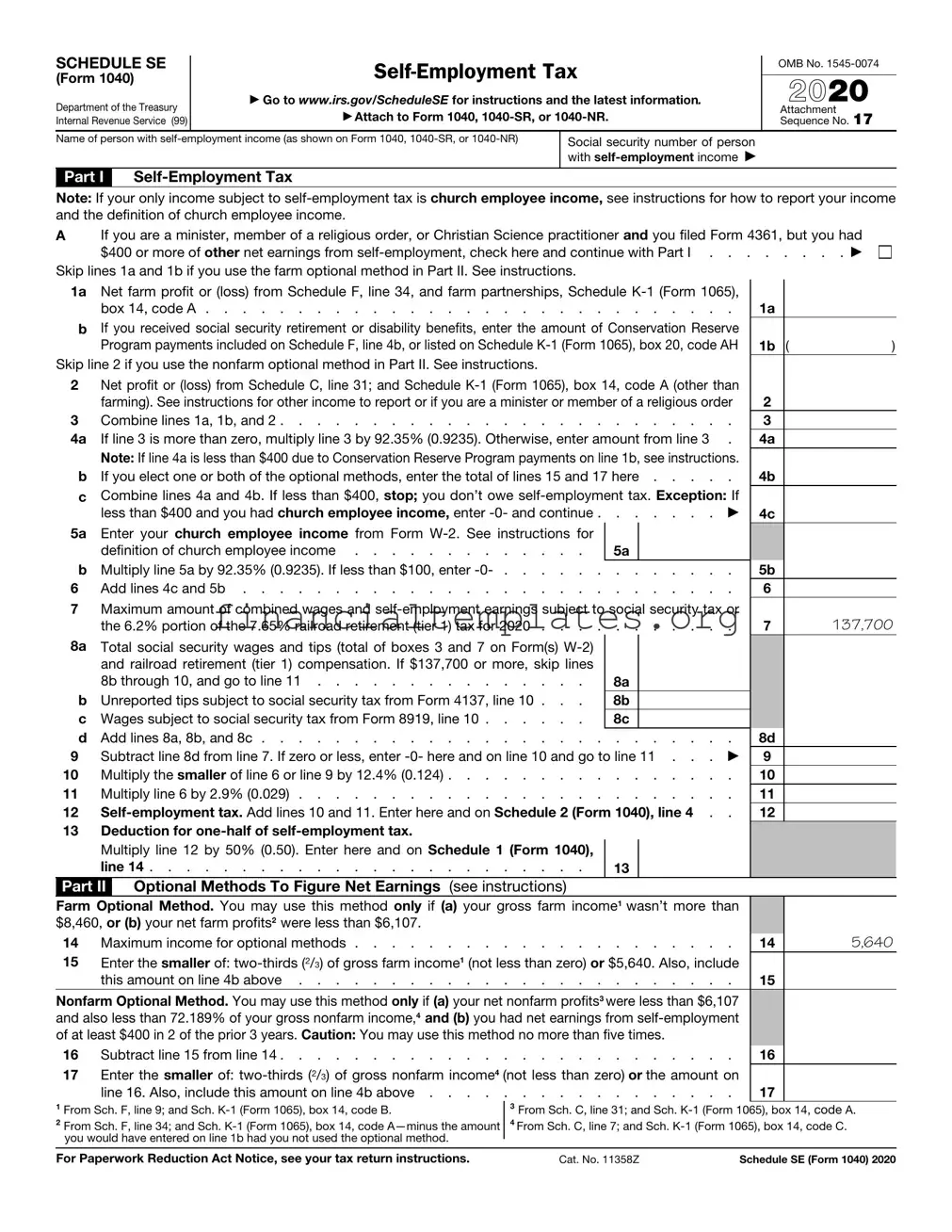The IRS Schedule SE 1040 form is closely related to the Form 1040, U.S. Individual Income Tax Return. Both forms are essential for individuals to report their annual income to the Internal Revenue Service (IRS). While the Form 1040 provides a comprehensive overview of an individual's income, deductions, and credits, Schedule SE specifically focuses on calculating the self-employment tax owed by individuals who earn income outside of traditional employment. This connection is vital because information from the 1040 form often feeds directly into Schedule SE to determine the self-employment tax due.
Another similar document is the IRS Schedule C (Form 1040), Profit or Loss from Business. This form is used by sole proprietors as well as single-member LLCs to report the income or loss from a business they operated or a profession they practiced as a sole proprietor. The income reported on Schedule C directly impacts the calculations on Schedule SE, as the net profit or loss from business activities on Schedule C is used to determine self-employment tax obligations on Schedule SE.
IRS Form 1099-MISC, Miscellaneous Income, also has similarities to Schedule SE. Form 1099-MISC is used to report payments made in the course of a trade or business to people who aren't employees, such as independent contractors. For individuals receiving a 1099-MISC, this income must be reported on Schedule C, which then influences the self-employment tax calculated on Schedule SE. Thus, 1099-MISC income is a critical component for many individuals completing their Schedule SE.
The IRS Schedule F (Form 1040), Profit or Loss from Farming, is akin to Schedule SE in that it impacts self-employment tax calculations for individuals involved in farming activities. Farmers utilize Schedule F to report farm income and expenses. The net profit or loss from farming operations reported on Schedule F is then used to determine the self-employment tax on Schedule SE, highlighting the direct relationship between profit from farming and self-employment tax obligations.
IRS Form 4868, Application for Automatic Extension of Time To File U.S. Individual Income Tax Return, indirectly relates to Schedule SE. When individuals file Form 4868, they receive an extension on the deadline to file their Form 1040 and, by extension, Schedule SE. This correlation ensures that individuals who may need additional time to accurately report their income and calculate their self-employment tax can do so without penalty.
The IRS Schedule 1 (Form 1040), Additional Income and Adjustments to Income, interacts with Schedule SE by requiring certain types of additional income to be reported, some of which may affect self-employment tax calculations. Specifically, income adjustments reported on Schedule 1 can impact the adjusted gross income figure used in the self-employment tax calculation on Schedule SE, thus connecting the forms in the overall task of income reporting and tax calculation.
IRS Form 8829, Expenses for Business Use of Your Home, is another document related to Schedule SE, especially for self-employed individuals who take a home office deduction. The expenses reported on Form 8829 can lower the net profit reported on Schedule C, consequently affecting the self-employment tax owed, as calculated on Schedule SE. This form demonstrates how business deductions impact self-employment tax liabilities.
The IRS Schedule K-1 (Form 1065), Partner's Share of Income, Deductions, Credits, etc., has a connection to Schedule SE for individuals who are partners in partnerships. The income or loss reported on Schedule K-1 affects the partner's individual income tax return, including the net earnings from self-employment that are subject to self-employment tax on Schedule SE. This form is crucial in determining how partnership income contributes to an individual's self-employment tax obligations.
IRS Form 1040-ES, Estimated Tax for Individuals, bears relevance to Schedule SE as it involves the estimated tax payments that self-employed individuals are often required to make. Based on the self-employment tax calculated on Schedule SE, along with other tax liabilities, Form 1040-ES helps individuals determine how much they should pay in estimated taxes quarterly to avoid penalties for underpayment of taxes due throughout the year.
Lastly, the IRS Form W-2, Wage and Tax Statement, while primarily for traditionally employed individuals, connects with Schedule SE for individuals who have both traditional employment and self-employment income. The W-2 reports wages on which Social Security and Medicare tax has already been paid, which can affect the calculation of self-employment tax on Schedule SE, ensuring that individuals do not overpay into Social Security and Medicare.

